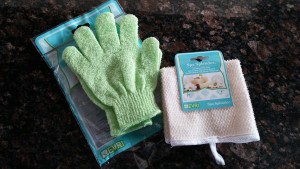Want to have glowing, nourished skin even when it is cold and dry out? Here are some “winterizing” tips to prepare your skin:
- Use only safe, non-toxic, non-carcinogenic products on your body. Unfortunately, many retail products still contain questionable ingredients. Check your product labels! Just because it is expensive or a “brand name” does not mean it is the best or safe.
- I know the air is colder but try not to raise the temperature of the water you use in the bath or shower. The hotter the water, the more it dries out your skin!

- Exfoliate and remove the dead skin flakes. This way when you apply moisturizers they will hydrate your living skin – not the skin flakes that are about to fall off! Use a fresh mitt or cloth in the shower with a moisturizing bath bar or body wash. Yep – that means 7 on the shelf so you can use fresh each day. Used ones can be air dried, then placed in your washer on laundry day – just like you would a washcloth. Warm water wash and air dry – the dryer may get too hot for these fabrics.
- For any type of cleaning (personal hygiene or home cleaning) I recommend synthetic since natural fibers are not able to be cleaned effectively and definitely not disinfected. Natural fibers like a loofah take a long time to dry (if ever) and may grow microorganisms that are not good for anyone’s skin but especially bad if you are immunocompromised in any way. If you are not used to exfoliating (physical cloth rubbing skin to remove dead skin cells) you may want to start with a simple fabric washcloth. Some find the loopy soft plastic puffs or washcloths with a loopy plastic side a bit more effective. In a few weeks you may try the exfoliating gloves – caution – they may be too exfoliating for sensitive or thinner over-50 skin. Have thos annoying upper arm bumps? (which can occur on a number of body areas – see article on 3.31.2017 for more info). Exfoliating cloth/mitt is the best treatment for those bumps many people get on the back of their upper arm combined with hydrating body wash, then apply protective lotion/cream/oil over the moist skin.
- Another option for exfoliation are some of the wonderful salt, sugar and blend scrubs available. I prefer to use these products in the bath so the wonderful, healing ingredients can absorb nicely into the skin after your scrub. Really wonderful if you can find a kind soul to scrub your back too! There are many D-I-Y recipes online – salt or sugar are excellent exfoliators mixed with a healing oil like coconut or almond. For additional benefits, think about incorporating essential oils that leave skin dewy after the salt polish. To keep jars sanitary, use a spoon or spatula to remove what you need. Wash the spoon between uses to avoid contamination jars. I prefer to make things more liquid and put in a squirt bottle. Keep the nozzle free and clear of the skin. For more ideas on keeping things clean, check out my article “The Hand Towel Did It” on 6.30.2019.
- Turn your bath into soothing skin therapy by adding a capful of hydrating, calming bath oil. Add some Epsom salts for a healthy body detox plus the added magnesium and sulfur!
- After your bath and shower, best to let yourself air dry and apply your lotion while your skin is still moist. Be sure to use a moisturizer with a protectant so you don’t lose all the moisture in your skin back into the air. During the really cold or dry months, add your favorite essential oils, almond oil or other oils to boost the healing and sealing power! Lots of evidence that a relaxing bath, helps one have a good night’s sleep – proper sleep helps the skin look and feel it’s best too!
Using these tips your skin will be polished and nourished – ready for the cold and dry season. With skin being your largest organ, consider using these tips year round to keep it healthy and protecting you.
If you found this information helpful, let us know! If you have any medical conditions, please consult your medical professional before following any of my suggestions here.
Questions, thoughts? You can call/text at (847) 502-8394, email at Liz@elizabethanthonygronert.com or find me on Facebook (Elizabeth Anthony Gronert). We look forward to helping you and your family have Comfort For Life! Elizabeth & Kris Gronert



